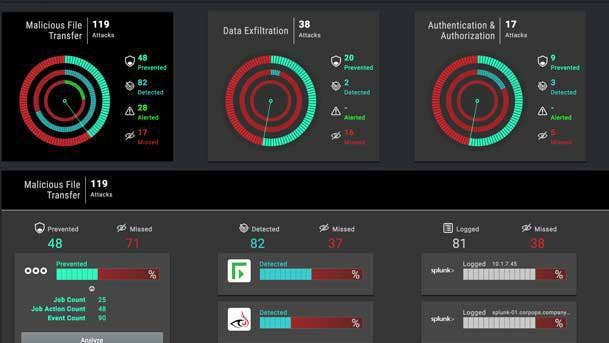10 Things To Know About The FireEye-McAfee Enterprise Deal
From who will lead the company going forward to how the FireEye and McAfee Enterprise products fit together to why both businesses have struggled in recent years, here are the 10 key things to know.

The New Old Vanguard
Private equity firm Symphony Technology Group (STG) announced Thursday that it will be combining McAfee Enterprise and FireEye Products into a nearly $2 billion cybersecurity behemoth with more than 40,000 customers and 5,000 employees. STG closed its $4 billion acquisition of McAfee Enterprise in late July and is expected to close its $1.2 billion buy of FireEye Products in the fourth quarter of 2021.
“Cyber risk is the number-one threat facing modern organizations and we are excited to advance our growing portfolio of cybersecurity companies,” STG Co-Founder and Managing Partner William Chisholm said in a statement. STG anticipates bringing together McAfee Enterprise and FireEye Products next quarter to offer customers protection across endpoints, infrastructure, applications and in the cloud.
From who will lead the combined company going forward to how the FireEye and McAfee Enterprise product portfolios fit together to why both businesses have struggled to grow in recent years, here are the 10 biggest things to know about the impending FireEye-McAfee Enterprise megamerger.

10. Deal Largely Undoes FireEye’s 2013 Mandiant Acquisition
STG’s FireEye Products buy largely undoes FireEye’s $1 billion purchase of Mandiant in December 2013, which brought together FireEye’s signatureless web, email, data center, and mobile security platform with Mandiant’s endpoint security and incident response. Kevin Mandia founded Mandiant in 2004 and served as FireEye’s COO for two-and-a-half years after the deal before becoming CEO in June 2016.
However, not everything that was developed by Mandiant will remain with Mandiant once the separation is complete. Specifically, the company’s endpoint security technology and Helix cloud SIEM (security information and event management) platform will move over to STG as part of FireEye even though the capabilities were originally developed by Mandiant, Mandia said in June.
STG will be acquiring FireEye’s security control products based on the company’s detection, prevention, and analysis technologies. The company’s network, email and endpoint security capabilities can be delivered through an integrated hardware appliance, a virtual software sensor, via Software as a Service (SaaS), or though a hybrid on-premise and cloud-based model, according to the company.

9. STG Owns The FireEye Name, But Not The McAfee Name
A name for the combined McAfee Enterprise-FireEye Products business hasn’t been disclosed yet, according to a McAfee Enterprise spokesperson. Symphony Technology Group (STG) obtained rights to the FireEye name as part of its acquisition of the products business, but the McAfee name remains with the company’s $1.56 billion consumer business.
The publicly traded entity known today as FireEye will be renamed Mandiant next week and change its ticker symbol to MNDT in preparation for the closing of the FireEye Products sale. Assets remaining with Mandiant include the company’s threat intelligence and incident response services business. Sales for the Mandiant business surged to $399.7 million in 2020, up 20.6 percent from $331.4 million in 2019.
FireEye was once the darling of the cybersecurity industry, with the company’s shares trading at more than $85 per share five months after the company first went public in February 2014 and Cisco allegedly putting in a $9 billion bid to purchase the company in May 2015. But FireEye’s stock has been stuck trading at under $25 per share since November 2015 and the entire company is worth just $4.28 billion.

8. Both Businesses Have Seen Widespread Layoffs In Recent Years
McAfee initiated a workforce reduction in December 2020 to improve operating margins and reorient its Enterprise business and announced the move on Feb. 23 after affected employees had been notified. The company was slated to spend $16 million in the fourth quarter of 2020 and $30-to-$35 million in the first half of 2021 on the restructuring, consisting of severance payments and other termination benefits.
The company notified the state of California Jan. 4 that it would be laying off 137 employees at its San Jose headquarters effective March 4. Three vice presidents of engineering and product management and two senior directors of sales and product management are among the higher-level employees to be laid off in the move, according to filings with the state.
Likewise, FireEye reduced its headcount by 7 percent over the course of 2020 to align expenses more closely with the company’s projected revenue and position the company for improved operating performance. The company spent $26.5 million on the restructuring over the course of 2020, and the cuts reduced FireEye’s non-GAAP operating income by over $26 million in 2020 as compared with 2019.

7. Combined Company Has More Workers Than All But Four Peers
Approximately 1,300 of FireEye’s roughly 3,400 employees are expected to move over to STG as part of the product business, while the remaining 2,100 employees will remain with the Mandiant Solutions business, the company disclosed in June. Across the company, less than 40 percent of workers will become part of FireEye products.
The divide is more equal, however, in the go-to-market organization. Just over 400 of the company’s sales and marketing employees will remain with Mandiant Solutions, while approximately 380 will join STG as part of the FireEye products business, according to CFO Frank Verdecanna.
The combined FireEye-McAfee Enterprise is expected to have more than 5,000 employees, giving it a larger headcount than companies like CrowdStrike, Okta, Proofpoint and Zscaler despite being worth far less than any of those companies. Only four publicly traded enterprise security companies will have more employees than the combined entity: Palo Alto Networks, Fortinet, Trend Micro, and Check Point.

6. FireEye, McAfee Enterprise Multiples Pale In Comparison To Peers
STG bought McAfee’s $1.35 billion enterprise business at a 3X revenue multiple and has agreed to purchase FireEye’s $541 million product business at a multiple of just 2.2X over the company’s applicable 2020 revenue. That compares unfavorably to the 4.3X revenue multiple Broadcom agreed to pay in August 2019 for Symantec’s $2.5 billion enterprise business.
In contrast, Wall Street cybersecurity darlings CrowdStrike, Okta, SentinelOne and Zscaler have all gone public since 2017 and today have valuations of 64X, 44X, 155X, and 54X revenue, respectively, from their most recent fiscal year.
Talks about splitting McAfee and FireEye into two have persisted for years, with DealReporter writing in October 2019 that FireEye was holding talks to potentially sell its products business after struggling to find buyers for the entire company. The Wall Street Journal, meanwhile, said in December 2019 that McAfee was examining scenarios where its enterprise and consumer units would have different owners.

5. Sales Stagnant At Both FireEye and McAfee Enterprise
FireEye’s product business has struggled for several years due to the persistence of legacy, on-premise appliance-based technology. Revenue for the company’s product business fell to $540.9 million in 2020, down 3 percent from $557.8 million a year earlier. That’s despite the surge in cybersecurity spending that accompanied the rapid shift to remote work at the onset of the COVID-19 pandemic.
McAfee’s enterprise business has similarly struggled in recent years as it faces off against high-powered competitors like CrowdStrike and SentinelOne. Net revenue for the fiscal year ended Dec. 26, 2020, inched ahead to $1.35 billion, up just 1.2 percent from $1.33 billion a year earlier. And the division’s operating loss increased to $180 million, up 19.2 percent from $151 million a year earlier.
In the most recent quarter, FireEye Product sales inched ahead 1 percent from $132.7 million to $134 million, while net income fell 6.2 percent from $36.7 million to $34.4 million, or $0.15 per diluted share. McAfee Enterprise revenue for the first quarter of 2021 – the most recent reported – came in at $331 million, unchanged from the year prior, while adjusted net income jumped 47 percent to $88 million.

4. Private Equity Owner of FireEye-McAfee Also Owns RSA, RedSeal
Private equity firm Symphony Technology Group has been around since 2002 but shied away from security until April 2019, when it took a majority stake in network modeling and risk scoring platform RedSeal for a reported $100 million, according to Momentum Cyber. STG made a much bigger splash in September 2020 with its $2.08 billion purchase of Bedford, Mass.-based encryption vendor RSA.
Then in April 2021, STG brought in private equity firm Clearlake Capital to be an equal ownership partner in RSA. Under STG, RSA has stood up each of its product lines as independent business units with its own name and executive team. RSA CEO Rohit Ghai also serves as the top executive for the NetWitness threat detection and response and SecurID identity and access management businesses.
STG, meanwhile, tapped Oracle veteran Bill Diaz to lead the Archer governance, risk and compliance business, while the Outseer fraud and risk intelligence business is led by ThreatMetrix exec Reed Taussig. STG also has control over the RSA Conference, the world’s largest cybersecurity event which in 2019 drew more than 42,500 people and 700 vendors to San Francisco’s Moscone Center.

3. FireEye, McAfee Enterprise Have Lots Of Overlapping Capabilities
There is significant overlap between the FireEye and McAfee Enterprise product portfolio, most notably about Security Information and Event Management (SIEM), where FireEye has Helix and McAfee has Enterprise Security Manager. FireEye’s Cloudvisory offering overlaps with McAfee’s cloud security portfolio, and the two companies have very similar capabilities in endpoint and network security.
FireEye’s flagship product coming out of its separation from Mandiant is its extended detection and response (XDR) platform, which offers native security protections for endpoint, network, email, and cloud. McAfee Enterprise also has its MVision XDR offering, which was expanded in May through correlations with the company’s endpoint security product, SASE platform, and threat intelligence tool.
“FireEye has always put its focus on relentlessly protecting its customers from targeted threats and with FireEye XDR we have taken the next step in simplifying threat detection and response,” Bryan Palma wrote in August when FireEye XDR debuted. “FireEye XDR is an architecture connecting all FireEye technologies and expertise, as well as third-party sources together for a seamless analyst experience.”

2. Combined Company Has Three Experienced Channel Chiefs
The current top leaders for McAfee’s Enterprise business are Lynne Doherty (pictured), who has run sales, pre-sales, channel and marketing since May 2020, and Shishir Singh, who has led product strategy and execution since Jan. 1. Doherty previously led Cisco’s U.S. Commercial Sales team, while Singh joined McAfee in October 2014 and was SVP of engineering before becoming McAfee’s chief product officer.
Other notable executives in the FireEye Products business under Palma include: Pat Sheridan, an eight-year FireEye veteran who spent most of his time in the U.S. public sector space before becoming SVP of Americas for the company in January 2020; and Michelle Salvado, a three-year FireEye veteran who has overseen engineering for the company’s endpoint, email and Helix security platform since late 2020.
Each organization also brings experienced channel leadership to the table. Chris Carter has served as FireEye’s Americas channel chief since January 2016, and will be running channels for FireEye Products following the sale to STG. On the McAfee Enterprise side, Kathleen Curry joined as global channel chief in April 2020 from Apple, while 28-year vet Ken McCray has led Americas channels since January 2016.

1. Ex-BlackBerry, Riverbed Execs Tapped To Lead Company
The top executive for the combined McAfee Enterprise-FireEye Products business will be Bryan Palma (pictured), who joined FireEye in February of this year as executive vice president of products. Over the past seven months, STG said Palma has partnered closely with FireEye CEO Kevin Mandia to define the future for the business, revamp the business’s product strategy, and lead the eventual $1.2 billion sale to STG.
Palma previously served as BlackBerry’s president and chief operating officer, Cisco’s senior vice president and general manager of Americas’ customer experience, and Boeing’s vice president of cyber and security solutions. In those roles, Palma has overseen business units with up to $8 billion in annual sales and led thousands of salespeople, engineers, developers, and consultants, according to STG.
Ian Halifax recently joined McAfee Enterprise as its chief financial officer and will become CFO of the combined company once the merger closes. Halifax served as Riverbed Technology’s chief financial officer since December 2019, and has over the past two decades transformed the financial operations of numerous software and cloud technologies companies and overseen many acquisitions and divestitures.